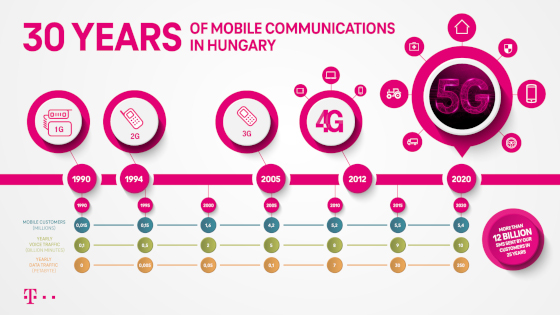The mobile revolution in Hungary started 30 years ago
On October 15, 1990, the analogue 450 MHz radiotelephone service was launched by Westel Rádiótelefon (later Westel 0660) Kft., which was established as a joint venture between Magyar Telekom's legal predecessor, Matáv, and US West International. It was also the first commercial mobile service in Central Europe. This was followed in 1994 by the second generation (2G) GSM-based service launched by Westel 900 (later T-Mobile Hungary, thenMagyar Telekom)in the 900 MHz band. The GSM system, compared to the analogue service, provided customers with better quality voice, higher network capacity, the ability to send text messages (SMS), voicemail and roaming. T-Mobile was also the first to launch the 3G mobile service in Hungary in 2005, enabling the use of high-quality multimedia applications, video telephony, mobile TV and high-speed mobile internet.
The real experience of mobile internet was finally brought by the next, fourth generation (4G/LTE) service, which Telekom has been offering to customers from the beginning of 2012. This technology still plays a significant role in servicing customers, as according to NMHH’s data in the 2019 Q4 96,3% of the total domestic mobile internet traffic and 25,2% of the domestic call traffic took place through 4G networks. Telekom provides high-quality 4G services in almost the entire territory of Hungary, in 3,120 settlements and its outdoor 4G coverage exceeds 99% while the indoor 4G coverage is close to 90%.
It has always been important for Telekom to make the latest technologies available to its customers as soon as possible. Therefore, shortly after its successful participation in the 5G frequency auction, the company launched its commercial 5G service in April this year, which now offers gigabit speed mobilnet* in 16 settlements at Lake Balaton and in 5 county capitals (Zalaegerszeg, Debrecen, Szeged, Kecskemét and Szombathely) in addition to Budapest and Budaörs. In addition to 5G network coverage one needs a 5G-capable device and a suitable mobile data package to use it. From September 4 Telekom offers the 5G service available in two unlimited data packages as a default service. Telekom plans to further increase its 5G coverage by the end of the year. Enabling much higher data transmission rates, low latency and connectivity to a wide range of network devices the 5G technology will offer new opportunities for both industrial use and in people's daily lives.
The annual voice traffic is still growing on Telekom's mobile network and is expected to reach 10 billion minutes this year, while in 2015 it was approximately 9 billion minutes. The annual data traffic is growing much steeper than voice, it grew with more than eight times then it was five years ago, growing with 60% in the second quarter of this year compared to last year’s Q2 data. Telekom customers have used an average of 5,5 GB of data per month so far in 2020.
The unbroken success of mobile telephony is shown by the fact that there are a total of 11,3 million activated SIM cards in Hungary today. Magyar Telekom has maintained its market leading position from the very beginning, with a market share of 44,8% at the end of 2019. The number of SIM cards in Telekom's network is nearly 5,4 million (almost 65% of them are postpaid) and the number of mobile broadband subscriptions is 3,18 million.
*Partial settlement coverage. The maximum download speed offered by the 5G service is 1 Gbps, the achievement of which depends on the availability of a device with sufficient capability and support for the given technology; i.e. whether the network supports the given speed and whether the radio and traffic conditions are sufficient.

The most important milestones of Telekom's mobile services in the last 25 years were as follows:
- October 15, 1990:launch of Westel 450's analogue mobile service, the first commercial mobile service in Hungary and Central Europe.
- 1994:a joint venture between Matáv and US West, Westel 900 (T-Mobile from 2004, Magyar Telekom from 2006) and Pannon GSM, a Scandinavian-Hungarian company (now Telenor Hungary) launched their GSM digital service (2G) in the 900 MHz band.
- 1995:The first SMS in Hungary was sent on te Westel 900 network. In the last 25 years, Telekom's customers have sent nearly 12 billion SMS messages.
- 1999:The third mobile operator, Vodafone Hungary, enters the market.
- 2000:Westel 900 has more than 1 million customers.
- 2001:Westel launched the GPRS service, a packet-switched data service that offers mobile internet and the use of multimedia applications, offering the speed of up to 30 Kbit/s.
- 2002:for the first time the number of mobile phone subscribers exceeded the number of fixed telephone lines at Telekom Group; Telekom is the first service provider in the world to introduce multimedia messaging (MMS) for text, image, audio and video content.
- 2003:450 MHz (0660) the analogue mobile service was phased out, existing customers were migrated to GSM.
- 2004:Westel took the name of T-Mobile, the official name of the company became T-Mobile Magyarország Távközlési Rt.
- 2005:T-Mobile launched the third-generation (3G) mobile network with UMTS system enabling high-quality multimedia applications, video telephony, mobile TV and high-speed mobile internet - first in Hungary.
- 2006:Magyar Telekom Rt. and T-Mobile Magyarország Rt. have merged, and as of March 1, 2006 the legal successor of T-Mobile Magyarország Rt., Magyar Telekom Plc. launched the high-speed downlink packet access (HSDPA) service (3 Mbps download speed) which has led to a rapid increase in the number of mobile internet subscribers.
- 2008:Magyar Telekom was the first in the country to offer television, internet and telephone on both fixed and mobile networks as a “triple-play” service provider, and it was the first to sell smartphones.
- 2009:Telekom was the first in Hungary to test the new generation 4G / LTE technology.
- 2012:The introduction of Telekom's commercial 4G service, as the first in the domestic market..
- 2014:With Telekom's LTE-Advanced (4G +) test network the next stage of mobile technology was made available in Hungary; Telekom's nationwide retail 4G coverage exceeded 78%.
- 2015:Telekom's retail 4G coverage reached 97% by the end of the year; Telekom's 4G mobile internet network achieved the best test results in independent international and domestic measurements and tests. From July 2015 the 4G data traffic permanently and increasingly exceeds 3G data traffic on Telekom's network.
- 2016:Telekom has started to cover small settlements with 4G technology and within a year the super high speed mobile internet reached more than 2,600 settlements with a population under 6,000. Meanwhile the company's 300 Mbps 4G+ service has been made available in more than 40 locations. Telekom made a test call on a 4G network (VoLTE - Voice-over-LTE technology). At the end of 2016 70% of the mobile data traffic is managed on the 4G network.
- 2017:Telekom was the first mobile operator in Hungary to launch voice services on a 4G network (VoLTE - Voice-over-LTE technology). Magyar Telekom has started the construction of a 5G test network at the automotive test track in Zalaegerszeg. Ericsson and Magyar Telekom introduced the first 5G connection in Hungary.
- 2018:Telekom was the first in the domestic market to use built-in SIM cards (eSIM) in its network. Telekom was the first in Hungary to offer MultiSIM (one subscription for several devices). Magyar Telekom was the first to present a real-time 5G network in Hungary in Magyar Telekom's headquarters in Krisztina körút, Budapest. In 2018 Magyar Telekom was the largest mobile phone and tablet seller in the Hungarian online retail market - based on GKI Digital's market analysis..
- 2019:Magyar Telekom launched Hungary's first standard 5G test station in Zalaegerszeg. According to the independent measurements of the international consulting company P3, Magyar Telekom's mobile network once again achieved the best overall result in voice and data services among the domestic mobile service providers for the fourth time. In 2019, Magyar Telekom was again the largest seller of mobile phones and tablets in the Hungarian online retail market, according to GKI Digital's market analysis.
- 2020:Magyar Telekom successfully participated in the 5G frequency auction, and shortly thereafter launched its commercial 5G service.
